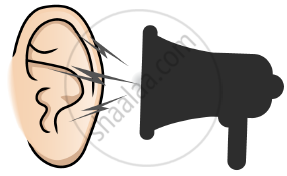Advertisements
Advertisements
Question
Given in the box below are a set of 14 biological terms. Of these, 12 can be paired into 6 matching pairs. Out of the six pairs, one has been done for you as an example.
Example : endosmosis - Turgid cell.
Identify the remaining five matching pairs :
| Cushing’s syndrome, Turgid cell, Iris, Free of rod and cone cells, Colour of eyes, Hypoglycemia, Active transport, Acrosome, Addison’s disease, Blind spot, Hyperglycemia, Spermatozoa, Endosmosis, Clotting of blood. |
Solution
(i) Blind spot: Free of rods and cones
(ii) Acrosome: Spermatozoa
(iii) Iris: Colour of eyes
(iv) Addison’s disease: Hypoglycemia
(v) Cushing’s syndrome: Hyperglycemia
APPEARS IN
RELATED QUESTIONS
Photoreceptor cells are present in __________.
(A) blind spot
(B) retina
(C) cochlea
(D) cornea
The number of oscillations per second of a vibrating object is called its time period.
Time taken by an object to complete one oscillation is called ___________.
Given below is a representation of a kind of pollution. Study the same and answer the questions that follow

(i) Name the kind of pollution.
(ii) List any three common sources of this pollution.
(iii) Mention three harmful effects of this pollution on human health.
(iv) Explain the term ‘Pollutant’.
(v) Name two soil pollutants
fill in the blanks with suitable functions: Ciliary body and __________.
Mention, where in living organism is the following located and state their main function:
Organ of corti
Mention if the following statement is true (T) or false (F) Give reason.
Malleus incus and stapes are collectively called the ear ossicles.
Name the part of the ear associated with hearing.
Complete the following sentence with appropriate word :
________ is the organ of balance and hearing in the body.
Given below is the diagram of the human ear. Study the same and answer the questions that follow:

(i) Give the biological term for the part labeled ‘A’ and state its function.
(ii) Name the part labeled ‘B’ and state its function.
(iii) Name the part labeled ‘C’ and state its function.
(iv) Give the function of ear wax.
State the functions of the following:
Semi-circular canals
Choose the Odd One Out:
Choose the Odd One Out:
State the functions of the following:
Auditory nerve
Given below is a diagrammatic representation of a part of the human ear.
- Name the parts numbered 1-6.
- Which parts of the ear shown here are complete.
 |
Note the relationship between the first two words and suggest the suitable word/words for the fourth place.
Semi-circular canal : Ampulla :: Cochlea : ______.
Where are the following located?
Eustachian canal
- Draw a neat and well labelled diagram of the membranous labyrinth found in the inner ear.
- Based on the diagram drawn above in (i), give a suitable term for each of the following descriptions:
- The structure responsible for hearing.
- The sensory cells that help in hearing.
- The membrane-covered opening that connects the middle ear to inner ear.
- The nerves that carry impulses from the ear to the brain.
- The tube which equalises the air pressure on either side of the ear drum.
